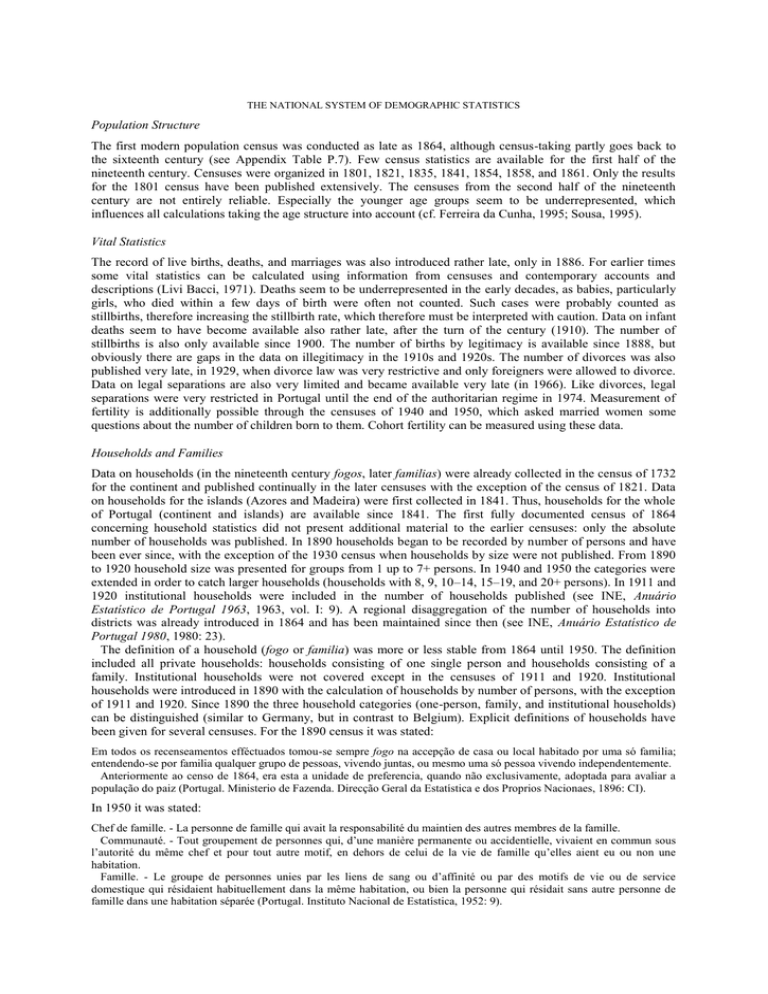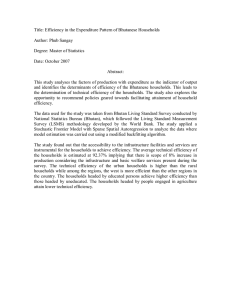p8.doc
advertisement

THE NATIONAL SYSTEM OF DEMOGRAPHIC STATISTICS Population Structure The first modern population census was conducted as late as 1864, although census-taking partly goes back to the sixteenth century (see Appendix Table P.7). Few census statistics are available for the first half of the nineteenth century. Censuses were organized in 1801, 1821, 1835, 1841, 1854, 1858, and 1861. Only the results for the 1801 census have been published extensively. The censuses from the second half of the nineteenth century are not entirely reliable. Especially the younger age groups seem to be underrepresented, which influences all calculations taking the age structure into account (cf. Ferreira da Cunha, 1995; Sousa, 1995). Vital Statistics The record of live births, deaths, and marriages was also introduced rather late, only in 1886. For earlier times some vital statistics can be calculated using information from censuses and contemporary accounts and descriptions (Livi Bacci, 1971). Deaths seem to be underrepresented in the early decades, as babies, particularly girls, who died within a few days of birth were often not counted. Such cases were probably counted as stillbirths, therefore increasing the stillbirth rate, which therefore must be interpreted with caution. Data on infant deaths seem to have become available also rather late, after the turn of the century (1910). The number of stillbirths is also only available since 1900. The number of births by legitimacy is available since 1888, but obviously there are gaps in the data on illegitimacy in the 1910s and 1920s. The number of divorces was also published very late, in 1929, when divorce law was very restrictive and only foreigners were allowed to divorce. Data on legal separations are also very limited and became available very late (in 1966). Like divorces, legal separations were very restricted in Portugal until the end of the authoritarian regime in 1974. Measurement of fertility is additionally possible through the censuses of 1940 and 1950, which asked married women some questions about the number of children born to them. Cohort fertility can be measured using these data. Households and Families Data on households (in the nineteenth century fogos, later familias) were already collected in the census of 1732 for the continent and published continually in the later censuses with the exception of the census of 1821. Data on households for the islands (Azores and Madeira) were first collected in 1841. Thus, households for the whole of Portugal (continent and islands) are available since 1841. The first fully documented census of 1864 concerning household statistics did not present additional material to the earlier censuses: only the absolute number of households was published. In 1890 households began to be recorded by number of persons and have been ever since, with the exception of the 1930 census when households by size were not published. From 1890 to 1920 household size was presented for groups from 1 up to 7+ persons. In 1940 and 1950 the categories were extended in order to catch larger households (households with 8, 9, 10–14, 15–19, and 20+ persons). In 1911 and 1920 institutional households were included in the number of households published (see INE, Anuário Estatístico de Portugal 1963, 1963, vol. I: 9). A regional disaggregation of the number of households into districts was already introduced in 1864 and has been maintained since then (see INE, Anuário Estatístico de Portugal 1980, 1980: 23). The definition of a household (fogo or familia) was more or less stable from 1864 until 1950. The definition included all private households: households consisting of one single person and households consisting of a family. Institutional households were not covered except in the censuses of 1911 and 1920. Institutional households were introduced in 1890 with the calculation of households by number of persons, with the exception of 1911 and 1920. Since 1890 the three household categories (one-person, family, and institutional households) can be distinguished (similar to Germany, but in contrast to Belgium). Explicit definitions of households have been given for several censuses. For the 1890 census it was stated: Em todos os recenseamentos efféctuados tomou-se sempre fogo na accepção de casa ou local habitado por uma só familia; entendendo-se por familia qualquer grupo de pessoas, vivendo juntas, ou mesmo uma só pessoa vivendo independentemente. Anteriormente ao censo de 1864, era esta a unidade de preferencia, quando não exclusivamente, adoptada para avaliar a população do paiz (Portugal. Ministerio de Fazenda. Direcção Geral da Estatística e dos Proprios Nacionaes, 1896: CI). In 1950 it was stated: Chef de famille. - La personne de famille qui avait la responsabilité du maintien des autres membres de la famille. Communauté. - Tout groupement de personnes qui, d’une manière permanente ou accidentielle, vivaient en commun sous l’autorité du même chef et pour tout autre motif, en dehors de celui de la vie de famille qu’elles aient eu ou non une habitation. Famille. - Le groupe de personnes unies par les liens de sang ou d’affinité ou par des motifs de vie ou de service domestique qui résidaient habituellement dans la même habitation, ou bien la personne qui résidait sans autre personne de famille dans une habitation séparée (Portugal. Instituto Nacional de Estatística, 1952: 9). Family statistics did not start before the 1950 census, when families were presented by the number of children for the first time. Results have been published for married couples and unmarried women by number of children. Remarks (also see introductory Table 6.1) There are no data on vital statistics in Portugal from official sources before 1886 (cf. also Mitchell, 1992).





